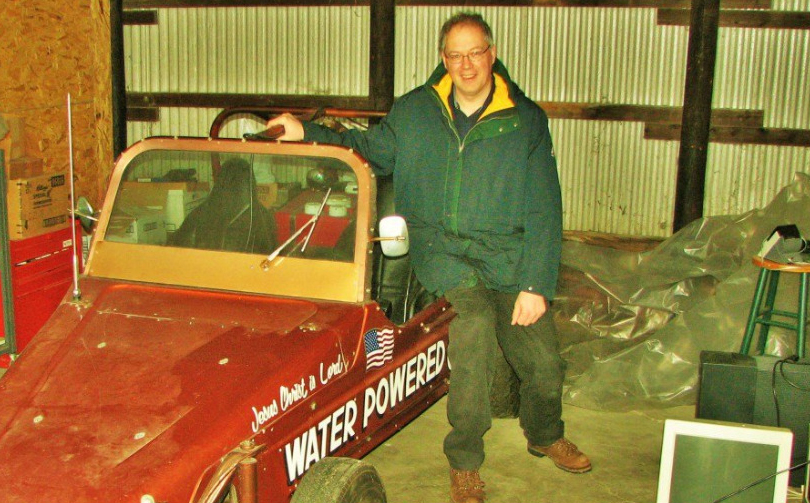There have been half a dozen working water-powered cars since the early 1800s. But back then Big Oil and Big Energy didn’t exist so nobody gave a crap.
When these Fat Cats took over the power, the simple powerful proven secrets behind this hydrogen-water engine got locked up tighter than Fort Knox.
There are many more unsung energy heroes, courageous inventors who risked everything, that were threatened, slimed, ruined, discredited or even killed by these Big Corporations, because they fought for your energy freedom.
The Paul Pantone story could end up in tragedy for him. Instead, when he saw what he was up against, he wisely made sure his secrets are well hidden and his dream will live on, by perfecting his water-powered generator in secret.
Before he died Paul Pantone, made sure that his secrets were kept hidden, guarded by people he trusted. His secret is about Water-Power Generator.
The shock will hit you hard when you will learn the simple truth about the water-power generator and car. The same fueled generator can be used to run a motorcycle, a speedboat, even an entire house.
Here is the story:
In 1942, Henry Wallace, the Vice
President of the United States, saw Pantone run a car on water power.
Right after the Wallace demonstration, the President of Bolivia witnessed the live proof as well.
They both told Pantone that he was invited to the Military Intelligence of the United States with his revolutionary invention.
He was invited to see Chief Military Intelligence
Service of the United States War Department.
At that time, it was believed that the generator might be helpful to the U.S. war efforts.
In April of that year, Mr. Pantone successfully demonstrated his generator to the Bureau of Standards in Washington DC and applied for a U.S. patent.
But, because there was a war going on, all U.S. patents had to be sealed for one year.
After the year was up, Pantone received a
letter from the patent office stating that because of the high cost of aluminum
and magnesium (the two metals used in his invention) that his patent was
impractical.
His patent attorney, after several letters to the patent office, also advised him to shelve his patent until a later date, as petroleum was still believed plentiful and cheap.
In the 1970 ´s, when air pollution and oil shortage became a problem, Pantone "un-shelved" his generator believing that the time was finally right.
He secured a U.S. patent and a few years later, he received patents from Germany, Brazil and Japan.
Fresh from his success with the patent
process, Pantone believed he was just a few short steps away from changing the
world!
The naive and overly trusting inventor was eager to make history. After all, Pantone had been more than patient.
In February of 1974, with the hopes of acquiring government backing and support, Pantone demonstrated his water fuel cell to Congressman Robert Roe.
Mr. Roe seemed impressed and said that he would bring it to the attention of Washington officials.
Upon leaving, Mr. Pantone invited the
congressman to another demonstration he had planned later that year at Point
Pleasant, New Jersey.
Congressman Roe was invited to take part in a history making voyage; the first power boat ride fueled by seawater.
Many newspapers were invited as well.
Congressman Roe did not show up and neither did many newspapers. Mr. Pantone never heard from the Congressman again about his invention or the promise to bring it to the attention of appropriate Washington officials, but his voyage was a success.
History was made on July 17th, 1974 when a 26 foot power boat ran for nine hours using the Pantone generator and seawater for fuel, putting back into the oceans its waste, only clean water.
Pantone also had his invention analyzed
by independent experts. The Pantone generator passed all tests at the New
Jersey Gollob Analytical Service Corporation Labs in September of 1973, and in
1979.
Nan Waters, a consulting chemist with the Aesop Institute analyzed the generator and wrote the following report:
"I have read the literature relating to Pantone´s hydrogen generator. In my opinion, there is no reason why it would not to work as described.”
Basically, he has combined in one device three very simple chemical principles;
a) The use of active metals to produce hydrogen from water,
b) The differing electrical potential of two metals to produce an electrical current,
c) The use of electrical current to produce hydrogen from water by electrolysis.
All the ideas are well known; they simply haven´t been put together this way before. It is so simple and elegant. "
In other words, IT WORKED!
Like many other brilliant, blindly optimistic and sadly unrealistic inventors before and after him, next Pantone tried to get Big Oil, the automobile industry arm of that ugly global octopus -- interested in his invention.
However, despite overwhelming evidence
that it worked, he was again confronted with skepticism or ignored.
He contacted energy companies and one such company, Consolidated Edison, sent a research chemist to see the generator in action.
The chemist was enthusiastic about the invention but when he took it back to his company, he told Mr. Pantone later, his company had no interest.
He sent details of his invention to all the major oil companies.
The response was either cool or nonexistent.
One oil company returned all papers to him in an unmarked envelope and then after a two hour meeting with him, a representative told him, "We are in the oil business. Your invention, if we were to develop it, would be against our interests."
Reading between the lines, Big Oil was admitting that Pantone’s invention would put them out of business!
In 1977, Pantone used his generator to provide all the power for his neighbor's new house. The New Jersey Commissioner of Energy and their staff saw the demonstration but did nothing about it.
Blocked by Big Oil...and getting nowhere with government and the energy industry, Pantone now turned to the news and entertainment media.
In 1980, it seemed like Pantone's prayers had been answered.
The popular CBS TV news program "60 Minutes" called him.
They said they were impressed by his demonstrations and wanted to do a whole show about his water powered generator.
The camera crew arrived on schedule and videotaped everything. All went well with the live demonstrations of powering a hydrogen burner, operating an electric motor, filling a balloon with gas and running a torch that burned through ¾ thick steel plate with his water fuel hydrogen generator.
For the finale, Pantone was going to run a lawnmower on water.
Embarrassed by his old funky lawnmower, he had gone out and bought a shiny brand new one.
Unfortunately, he did not have time to test it.
When he ran it for the live demonstration in front of the "60 Minutes" cameras, the brand new lawnmower choked and died.
The 60 Minutes crew reassured Pantone and told him not to worry.
They said they had enough footage of the successful demonstrations to complete a program.
When the "60 Minutes" show finally aired, Pantone was devastated.
The ONLY part of the impressive demonstration that they included was the failed lawnmower. They claimed his invention was a fraud!
Big Oil owns Big Media, too. They made sure that Pantone’s moment of fame went up in flames.
They succeeded. After their deceptive media smear campaign, Pantone was at first devastated by this betrayal.
However, his belief system that motivated his research for 50 years, despite the obstacles and frustrations experienced along the way, kept him focused.
In 1986, he wrote to the Department of Energy about his generator, addressing each of their points with technical data on his system, showing them that the system he developed would overcome the obstacles they described.
His detailed response was ignored.
After a lifetime of effort to help the world, he remains firm in his convictions. He humbly but strongly believes in the words of an old wise man who once told him, "SON, God put on your shoulders something very big. Do not ask yourself, why me? Think why not me?"
Pantone labored in obscurity until he
died a sad quiet forgotten death forgotten, that is, until now.
Why now?
It turns out that Pantone's grandson
holds the patent rights to the Pantone Generator and the blueprints.
He's kept them closely guarded and safe
from harm, a valuable family legacy. The plans are intact. They are ready to
power your car right now!
Click HERE to find out how you can run your car with water.
Source: energyliberationarmy.com - Todd Harper
brought to you by How Can We Save Energy



